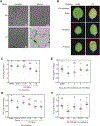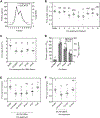Protective plant immune responses are elicited by bacterial outer membrane vesicles
- PMID: 33472073
- PMCID: PMC8158063
- DOI: 10.1016/j.celrep.2020.108645
Protective plant immune responses are elicited by bacterial outer membrane vesicles
Abstract
Bacterial outer membrane vesicles (OMVs) perform a variety of functions in bacterial survival and virulence. In mammalian systems, OMVs activate immune responses and are exploited as vaccines. However, little work has focused on the interactions of OMVs with plant hosts. Here, we report that OMVs from Pseudomonas syringae and P. fluorescens activate plant immune responses that protect against bacterial and oomycete pathogens. OMV-mediated immunomodulatory activity from these species displayed different sensitivity to biochemical stressors, reflecting differences in OMV content. Importantly, OMV-mediated plant responses are distinct from those triggered by conserved bacterial epitopes or effector molecules alone. Our study shows that OMV-induced protective immune responses are independent of the T3SS and protein, but that OMV-mediated seedling growth inhibition largely depends on proteinaceous components. OMVs provide a unique opportunity to understand the interplay between virulence and host response strategies and add a new dimension to consider in host-microbe interactions.
Keywords: OMV; Pseudomonas fluorescens; Pseudomonas syringae; bacterial virulence; extracellular vesicles; oomycetes; plant immune response; plant immunity; secretion.
Copyright © 2021 The Authors. Published by Elsevier Inc. All rights reserved.
Conflict of interest statement
Declaration of interests The authors declare no competing interests.
Figures





References
-
- Alfano JR, and Collmer A (2001). CHAPTER 5 - Mechanisms of Bacterial Pathogenesis in Plants: Familiar Foes in a Foreign Kingdom. In Principles of Bacterial Pathogenesis, Groisman EA, ed. (Academic Press; ).
-
- Bahar O, Mordukhovich G, Luu DD, Schwessinger B, Daudi A, Jehle AK, Felix G, and Ronald PC (2016). Bacterial Outer Membrane Vesicles Induce Plant Immune Responses. Mol. Plant Microbe Interact. 29, 374–384. - PubMed
-
- Bakker PAHM, Pieterse CMJ, and van Loon LC (2007). Induced Systemic Resistance by Fluorescent Pseudomonas spp. Phytopathology 97, 239–243. - PubMed
Publication types
MeSH terms
Substances
Grants and funding
LinkOut - more resources
Full Text Sources
Other Literature Sources
Molecular Biology Databases

